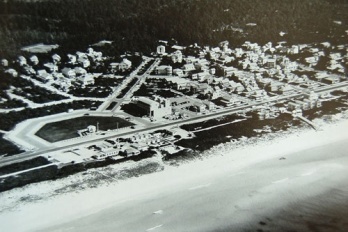Foto aérea de Seaside, Flórida, no começo do empreendimento fundador do New Urbanism, desenhado por Andrés Duany e Elizabeth Plater-Zyberk em 1983: arquitetura “tradicional”, lotes pequenos e uso misto para propiciar a vitalidade urbana
[fonte: KOSTOF, S. The City Shaped – Urban Patterns and Meanings Through History. New York, Bulfin]
Anne Vernez Moudon: The first problem with this approach is how do you define a traditional city? What is a traditional city? People have had to face this problem in preservation and construction work. After World War Two, for example, the question was whether to reconstruct Warsaw as it was in 1790 or as it was in 1849. That was essentially a philosophic-political decision. The traditional city is not a fixed form, it is a moving form. We did not talk much about this notion of change in a city so far. Change is very difficult to understand, and to capture actually. Beyond the act of building, there is the lifespan of an environment, which changes within different time intervals. There is the short and the long lifespan. Space is being afforded and changed at many different levels. About the traditional city again, taking about its form, which one of its forms, over time, is deemed the traditional one? For instance, now in 2008, can we say that the city of the 1950s is the traditional city? Are today’s suburbs the contemporary traditional cities--we now have almost two generations of people who have lived in the suburbs? Most would agree that they are not part of the traditional city. Yet the city of the 1930s is often called traditional—and indeed urban forms of the early part of the 20th century are called traditional by the Congress for New Urbanism.
Regarding the use of and need for models, you have to ask yourself what is your model for. Does the model relate to one building, to an entire new section of a city? Where is it going to be applied, China, South America, where? Only then can you start thinking in terms of tradition and thinking in terms of innovation as well, because I think it makes no sense to continue the entire historical city forever. I am not answering exactly your question so, I think we urgently need to develop a model for the many new neighborhoods now being built in Asia. Korea, China, many of countries built sections of their cities (this is not incremental change!) in record time without explicitly considering different models.
AFR / DSP: Maybe they create the model…
AVM: In the absence of explicit and a priori models, the reality becomes the model! Then the problem becomes one where you cannot even evaluate what you build. So what would be the model for those “instant” neighborhoods that are as big as many towns elsewhere? Well, I don’t think that “my cherished Bastides town in the southern France would be a good model”. Neither will Clarence Perry’s Neighborhood Unit used in American cities, or the Unitè d’habitation used in many parts of the world. How would you start developing this model? You would start thinking of this model based on all these past ideas, and adapting them to the high densities of Asian cities today. I would think that concerns and solutions for energy consumption, water, garbage and waste, transportation systems, would be essential in developing that model.
AFR / DSP: So we can consider this question as an attack about the discourse of the New Urbanism. Because this words, traditional city, good model, they are always applying this discourse to design their cities. They are looking for the American traditional cities, there is a linkage with the European old cities and try to construct new suburb today, and you can see a lot of this in America.
AVM: The New Urbanism movement is so multi-leveled that I think it is really hard to criticize them as a block. You can criticize their choice of architectural style, the way they configure street-blocks, the way they mix income, their house types, etc. But you should not criticism them at the general level. On the other hand, many of the pieces of the New Urbanism are not models that will work outside the US. I know it’s fashionable to say, oh, we have new urbanism communities in China. Well this association is a stretch as it may only apply to the use of an architectural style that is similar to some of the new urbanism communities that are built here, even not all of them are like that. I think that New Urbanism is looking for an approach to the American city that accommodates the middle class. Only aspects of this approach may apply elsewhere.



